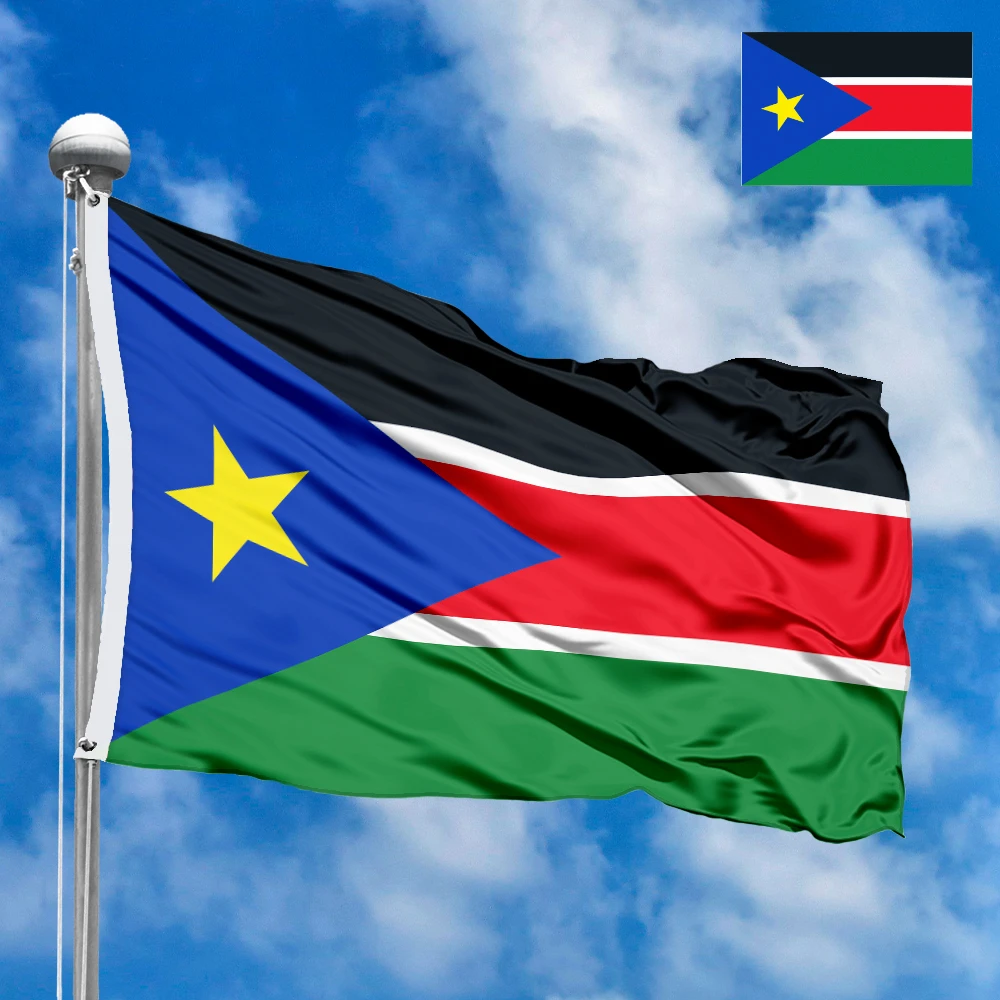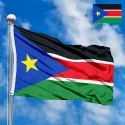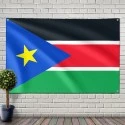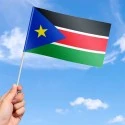The national flag of Sudan is a powerful and evocative emblem, deeply rooted in the nation's history, aspirations, and the diverse identities of its people. Adopted on May 20, 1970, it serves as a testament to Sudan's independence, its connection to the Arab world, and its African heritage. This comprehensive exploration delves into the design, symbolism, history, and significance of the Sudanese flag, highlighting its unique position as a beacon of unity and national pride for its citizens.
Design and Dimensions
The flag of Sudan is a horizontal tricolor of red, white, and black, with a green triangle placed at the hoist. This design is a classic example of Pan-Arab colors, incorporating elements that also resonate with African unity.
Symbolism of the Colors and Elements
Each color and element on the Sudanese flag carries profound historical and cultural significance, echoing the country's past struggles, its present aspirations, and its future vision.
-
Red: This vibrant color primarily symbolizes the sacrifices, blood, and martyrs who fought for Sudan's independence and freedom. It also represents the struggle and determination of the Sudanese people in their quest for sovereignty. Historically, red is often associated with the revolutions and sacrifices of Pan-Arab nationalism.
-
White: The central white stripe stands for peace, optimism, and light. It also represents the purity of the revolution that led to independence and the pure aspirations of the Sudanese people for a better future. Additionally, white can symbolize the rich agricultural lands along the Nile.
-
Black: The black stripe at the bottom refers to Sudan itself, as the word "Sudan" is derived from the Arabic "Bilad al-Sudan," meaning "Land of the Blacks." It also symbolizes the strength, resilience, and determination of the Sudanese people. Furthermore, black is a color of mourning for past oppression and a reminder of the country's African identity.
-
Green Triangle: The green triangle at the hoist is a multi-layered symbol. Primarily, it represents Islam, the predominant religion in Sudan, as green is traditionally associated with the faith. Beyond religion, green also symbolizes prosperity, hope, and agriculture, reflecting Sudan's fertile lands and its potential for growth and development. It evokes the verdant plains and the life-giving waters of the Nile.
Together, these colors and elements weave a narrative of a nation proud of its heritage, resilient in its struggles, and hopeful for a peaceful and prosperous future.
History of Creation and Adoption
The current flag of Sudan was adopted on May 20, 1970, following the military coup led by Gaafar Nimeiry in 1969. This adoption marked a departure from Sudan's previous flag and a strong alignment with Pan-Arab symbolism, reflecting the Nimeiry regime's Arab nationalist leanings.
Prior to 1970, from its independence in 1956, Sudan used a blue-yellow-green tricolor flag.
The shift to the current flag under Nimeiry was a deliberate move to visually connect Sudan more closely with the Arab world and to project a stronger Pan-Arab identity. The design was chosen to align with the flags of other Arab nations, many of which adopted similar red, white, black, and green color schemes in the mid-20th century.
Country, Region, and Acceptance
Sudan is a large country located in Northeast Africa, bordering the Red Sea. It is strategically positioned at the crossroads of Sub-Saharan Africa and the Middle East, which has profoundly influenced its history, culture, and demographics. Geographically, it is diverse, ranging from vast deserts in the north to fertile plains in the south and east.
The flag is the official national emblem of the Republic of Sudan and is universally accepted by the government and the vast majority of its citizens. It is displayed at all official buildings, schools, and public institutions across the country. Despite internal conflicts and political changes, the flag has remained a constant symbol of the Sudanese state.
Significance for the Inhabitants
For the people of Sudan, the flag holds profound and multifaceted significance:
-
National Identity and Unity: It serves as a primary symbol of national identity, uniting a diverse population comprising various ethnic groups, languages, and cultural traditions. It represents the shared sovereignty and collective future of all Sudanese.
-
Independence and Sacrifice: The red stripe, in particular, evokes the memory of the struggle for independence from Anglo-Egyptian rule and the sacrifices made by generations of Sudanese for their freedom.
-
Pan-Arab and African Heritage: The colors reflect Sudan's dual heritage – its strong ties to the Arab world through language and religion, and its deep roots in the African continent. This dual identity is a unique aspect of Sudanese culture.
-
Hope and Prosperity: The white and green colors offer a message of hope for peace, prosperity, and a bright future, despite the challenges the nation has faced. They symbolize the aspirations for stability and development.
-
Resilience: The flag, through its enduring presence, symbolizes the resilience and endurance of the Sudanese people in the face of adversity, including civil wars, economic hardships, and political upheavals.
Interesting Facts
-
Largest African Country (Pre-2011): Prior to the secession of South Sudan in 2011, Sudan was the largest country by area in Africa. The split altered its geographical size significantly.
-
"Land of the Blacks": The name "Sudan" itself is derived from the Arabic term "Bilad al-Sudan," meaning "Land of the Blacks," which the black stripe on the flag directly references.
-
Number of Pyramids: Sudan has more ancient pyramids than Egypt. The pyramids of Meroe, built by the Kushite civilization, are a UNESCO World Heritage site and a testament to Sudan's rich ancient history.
-
Nile River: The Nile River, the longest river in the world, flows through Sudan, with the White Nile and Blue Nile converging in its capital, Khartoum. This confluence is a vital geographical and cultural landmark.
-
Diverse Ecosystems: Despite large desert areas, Sudan boasts diverse ecosystems, including savannas, mountains, and coastal regions along the Red Sea, supporting a variety of wildlife.
-
Cultural Crossroads: Sudan has historically been a cultural crossroads, connecting ancient Egyptian, Nubian, Arab, and various African cultures, resulting in a unique cultural tapestry.
-
Varied Population: The population of Sudan is incredibly diverse, comprising numerous ethnic groups, each with its own distinct traditions, languages, and dialects. This diversity is a challenge but also a source of rich cultural heritage.
-
Official Languages: The official languages of Sudan are Arabic and English, reflecting its historical connections.
-
Post-2019 Revolution: The flag played a significant role as a symbol of unity and aspirations during the 2019 revolution, where it was widely displayed by protestors advocating for democratic change.
-
The Black Stripe Controversy (Historical Context): While the black stripe officially represents "Sudan," it has been a point of debate, with some interpretations linking it to a sense of African identity distinct from purely Arab nationalism, especially given the historical ethnic and regional tensions within the country. However, the official interpretation remains consistent with its Pan-Arab and national symbolism.
-
Economic Reliance: Historically, Sudan's economy has been heavily reliant on agriculture, particularly cotton and gum arabic, though oil became a major export before the secession of South Sudan. The green in the flag subtly alludes to this agricultural base.
-
Strategic Location: Its strategic location on the Red Sea and proximity to major trade routes have made Sudan a historically important region for commerce and cultural exchange.
In the demonstration images, full-size flags are shown with proportions of 2:3, and hand-held flags with proportions of 1:2.







 Waving flag
Waving flag
 Sizes:
Sizes:
 Round flag
Round flag
 Sizes:
Sizes:
 Rectangular flag 2:3
Rectangular flag 2:3
 Sizes:
Sizes: